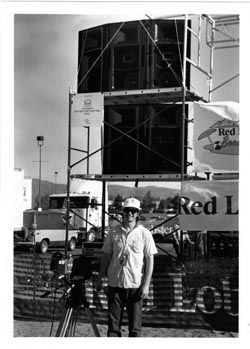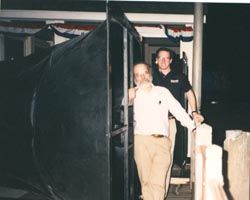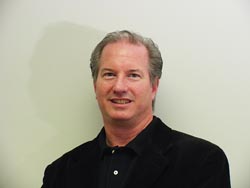Name: John Wiggins
Company: Community Professional
Title: Vice President, Business Development
Overtime: Now one of Community's owners, Wiggins joined the company three years after it was founded in 1968 by Bruce Howze.
SCN: How and when did you get involved in the crazy business of sound systems?
John Wiggins: Yours truly has been messing around with horns and automobiles for as long as I can remember. My family ran Wiggins Chevrolet in Lancaster County, PA and operated a small-town cinema on the side. Hence, my two present addictions: cars and loudspeakers.
The theatre was equipped with an RCA mono horn loudspeaker, a Simplex projector, and an RCA optical sound adaptor. Sound was literally bolted onto the side of an ancient silent movie projector. Clever, those RCA folks! The projection room even had a pair of 16-inch manual-sync Western Electric disc players from the very earliest "talkies" era.
On the automotive side, as a kid, the high point was unloading the dealership's very first secret split-window '63 Corvette Stingray from the car carrier and hiding it away in our backyard garage before its public debut. My Dad also had a '53 Corvette that he often drove me to the kindergarten in-top down, of course!
At the theatre the high point was seeing Elvis Presley in "Loving You" about fifteen times. God only knows what effect that may have on a young fella's mind!
At school they gave me a cello. After several years of torturing my music teacher, the school let me switch to drums. That was nirvana! In hindsight, my parents, who loved to dance, tolerated the drum-bashing and garage-band punishment rather well.
Drums led to rock and roll bands, which led me to RCA's Cameo Parkway Recording Studio in Philly where I recorded with Joe Dorsey and the Chapdelles. That was big fun for a fifteen-year-old. We appeared on a few TV shows and then promptly disappeared.
Since drums were not delightfully loud enough, I switched to roaring horn-loaded sound systems. My first loudspeakers were too exotic to even talk about. Window-shattering ceramic quarter-wavelength transmission lines at home, mass-loaded bass reflex enclosures, Lafayette coaxials, RCA sectorals, all powered by Bogens or some of the many kit Dynaco or Heathkit amplifiers. (Thank you, Dave Hafler. Thank you, Mike Rockwell.)
I moved to Philly from the Lancaster "Dutch" country to attend Penn State at their Abington campus. Shortly thereafter, I met Chas Gerber, who was providing sound for Small Faces, Rod Stewart, and Ronnie Wood's early band, and he introduced me to Mr. Thomas C. Walter and Mr. Bruce W. Howze. Basically, these guys were the real life "Flo and Eddie." For years, while working in the company of these two "larger-than life" fellows, I never stopped laughing. We headed off into the world of "Big Business" and forged the Community you know and love. The chief gonzo himself, Hunter S. Thompson, could not have hallucinated more purely devilish hippie inventors.
The first months of working with these jolly fellows we produced monitors for the Jefferson Airplane and a Leviathan tour system for Gene and Roy Clairs' tour with none other than that Elvis fellow. Interestingly, this was the Australian FOH metaphysician Bruce Jackson's first tour stint with The King.
Tour sound was booming, and our horns were selling like hotcakes in the early '70s, so we did not get much sleep. To this day, I think I have a huge sleep deficit built up over the years.
SCN: Would you ever have guessed that your work would take you around the world on a regular basis?

John Wiggins with a Community RS880 rig for Del Shannon at the 1988 Special Olympics Show. Mixed by Bill Porter, of Elvis Presley and Everly Brothers recordings fame.
SCN: In what ways has tour sound influenced installed sound, and vice versa?
JW: Excluding "hoot and holler" systems, better early installations were patterned after the work done preceding cinema sound by Edison, Dickson, Wente, Thuras, Rice, Kellogg, Shearer, Volkmann, Olson, Bell Labs, Western Electric, RCA, GE, Altec Lansing, and other Giants of Audio.
It has been a wonder to see all the technologies begin to synch with each other. Convergence is coming like an unstoppable meteor. Everything in audio and video will be an appliance on the network.
In the modern era, credit must go to the splendid Don and Carolyn Davis, and later Pat and Brenda Brown, for getting everyone in audio to talk to one another. It was a real breakthrough to have engineers, acousticians, recording engineers, system operators, and college professors, all speaking to one another, sharing their knowledge and experiences "down-home" style. Through SynAudCon we were introduced to brilliant folks like Dick Heyser, Don "DB" Keele, Gerald Stanley, Farrel Becker, Peter Mapp, Peter D'Antonio, Russ Berger, Diana Deutsch, Helmuth Kolbe, Tom Danley, and many, many others.
Once everyone was talking together and measuring audio systems and acoustical spaces using Dick Heyser's TEF or FFTs (including the tour sound people), things started to grow exponentially. Gary Hardesty's work with Motorola's first DSP, TOA's Saori, Rich Zweibel's DSP Matrix, combined with Don Keele's, Clifford Henricksen's and Mark Ureda's concepts of loudspeaker directivity control paved the way for John Prohs, Dr. Wolfgang Ahnert, Tom Birkle, Akira Motchimaru, and others to predict where to project sound with their new acoustical modeling software.
The "new" line arrays are extrapolations of the original Harry Olson 1938 column concept. As Don Davis says, "The ancients are stealing our inventions!" Occasionally, it is nice to see line arrays properly applied.
The touring industry has modularized into "plug and play" packages with all the high-minded technical stuff. Ignorance and convenience will always prevail. Can we get the roadie "Bart" from Hell-on-Wheels Audio to operate it?
Once we have automatic-system-self-optimization for 60,000 seats or so, installed sound and tour sound will be one and the same, except that one will be transportable and spiced up by pyro, squints, smashing perfectly good guitars, and "wardrobe malfunctions".

Bruce Howze (left) and John Wiggins being swallowed by the Leviathan II horn at Universal Studios, FL.
JW: At the risk of sounding a bit cynical, there are more reliable ways to make money. To the adolescent, good luck finding out what the difference is between love and passion. Pursue audio if you love it. Otherwise, play with it as a hobby.
The industry is not quite perfect; keep your hand on your wallet. Beware of the big shots; they are not too dependable.
SCN: Would you like to see a wine list this evening?
JW: A magnum of Petrus to share with close friends-1998, the year I married my wife.
SCN: How would you finish the following sentences?
There is much more to life than...phase, polarity, and group delay.
The weirdest thing I have ever eaten on a business trip...is "elephant nose" in China.
You'll never be lost if you...know celestial navigation.
Always make sure you carry a... spare everything.










